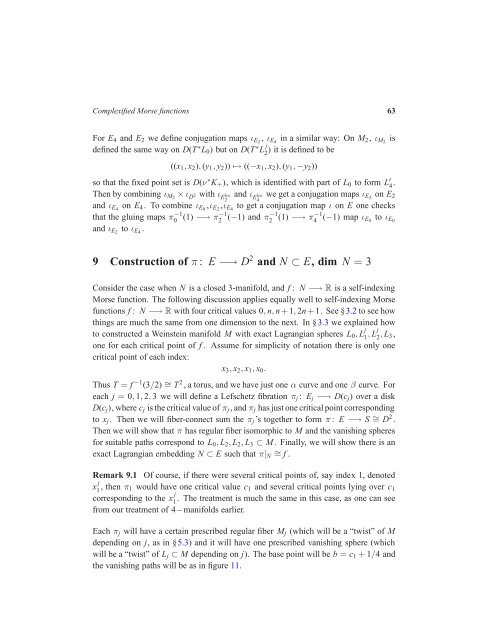The Picard-Lefschetz theory of complexified Morse functions 1 ...
The Picard-Lefschetz theory of complexified Morse functions 1 ...
The Picard-Lefschetz theory of complexified Morse functions 1 ...
You also want an ePaper? Increase the reach of your titles
YUMPU automatically turns print PDFs into web optimized ePapers that Google loves.
Complexified <strong>Morse</strong> <strong>functions</strong> 63<br />
For E4 and E2 we define conjugation maps ιE2 , ιE4 in a similar way: On M2, ιM2 is<br />
defined the same way on D(T∗L0) but on D(T∗L j<br />
2 ) it is defined to be<br />
((x1, x2), (y1, y2)) ↦→ ((−x1, x2), (y1, −y2))<br />
so that the fixed point set is D(ν ∗ K+), which is identified with part <strong>of</strong> L0 to form L ′ 4 .<br />
<strong>The</strong>n by combining ιM2 × ιD2 with ιEloc 2 and ιEloc 4<br />
and ιE4 on E4. To combine ιE0<br />
that the gluing maps π −1<br />
0<br />
and ιE2<br />
to ιE4 .<br />
we get a conjugation maps ιE2 on E2<br />
,ιE2 ,ιE4 to get a conjugation map ι on E one checks<br />
(−1) and π−1(1)<br />
−→ π−1<br />
(1) −→ π−1<br />
2<br />
2<br />
4<br />
(−1) map ιE0 to ιE0<br />
9 Construction <strong>of</strong> π : E −→ D 2 and N ⊂ E, dim N = 3<br />
Consider the case when N is a closed 3-manifold, and f : N −→ R is a self-indexing<br />
<strong>Morse</strong> function. <strong>The</strong> following discussion applies equally well to self-indexing <strong>Morse</strong><br />
<strong>functions</strong> f : N −→ R with four critical values 0, n, n+1, 2n+1. See §3.2 to see how<br />
things are much the same from one dimension to the next. In §3.3 we explained how<br />
to constructed a Weinstein manifold M with exact Lagrangian spheres L0, L j<br />
1 , Lj<br />
2 , L3,<br />
one for each critical point <strong>of</strong> f . Assume for simplicity <strong>of</strong> notation there is only one<br />
critical point <strong>of</strong> each index:<br />
x3, x2, x1, x0.<br />
Thus T = f −1 (3/2) ∼ = T 2 , a torus, and we have just one α curve and one β curve. For<br />
each j = 0, 1, 2, 3 we will define a <strong>Lefschetz</strong> fibration πj : Ej −→ D(cj) over a disk<br />
D(cj), where cj is the critical value <strong>of</strong> πj, and πj has just one critical point corresponding<br />
to xj . <strong>The</strong>n we will fiber-connect sum the πj’s together to form π : E −→ S ∼ = D 2 .<br />
<strong>The</strong>n we will show that π has regular fiber isomorphic to M and the vanishing spheres<br />
for suitable paths correspond to L0, L2, L2, L3 ⊂ M. Finally, we will show there is an<br />
exact Lagrangian embedding N ⊂ E such that π|N ∼ = f .<br />
Remark 9.1 Of course, if there were several critical points <strong>of</strong>, say index 1, denoted<br />
x j<br />
1 , then π1 would have one critical value c1 and several critical points lying over c1<br />
corresponding to the x j<br />
1 . <strong>The</strong> treatment is much the same in this case, as one can see<br />
from our treatment <strong>of</strong> 4−manifolds earlier.<br />
Each πj will have a certain prescribed regular fiber Mj (which will be a “twist” <strong>of</strong> M<br />
depending on j, as in §5.3) and it will have one prescribed vanishing sphere (which<br />
will be a “twist” <strong>of</strong> Lj ⊂ M depending on j). <strong>The</strong> base point will be b = c1 + 1/4 and<br />
the vanishing paths will be as in figure 11.
















